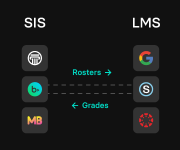| Today's career and technical education news from around the country | SIGN UP ⋅ SHARE |
|
|
 
| |
 |
| (Pixabay) |
A pilot program in Kentucky -- CLIMB 2.0 -- offers high-school students a pathway to careers in behavioral and mental health. The initiative, launched by the state's Council on Postsecondary Education along with the Cabinet for Health and Family Services, allows students to earn certifications that open the door to roles in the behavioral health sector after graduation or pursue further credentials.
|
|
|
 | Seamlessly Sync Your SIS and LMS
Flow keeps classes, rosters, assignments, and grades aligned across your Student Information System and Learning Management System, reducing manual work and keeping data accurate.
See how Flow works. |
|---|
| |
|
|
 
|
Wayne High School in Huber Heights, Ohio, has upgraded its career and technical education facilities with a $2 million grant. The project includes a new robotics, automation and manufacturing lab, as well as a renovated engineering lab with equipment such as 3D printers and CAD software, with the aim of providing hands-on learning experiences that align with regional industry demands.
|
|
|
Students often don't see the relevance of math when it's taught with abstract concepts rather than illustrated with real-life usage, such as a nurse measuring amounts of medicine. When instruction switches to career-based math, students see the connections and are more engaged and less likely to struggle with or fail college algebra -- a typical stumbling block to degree completion, write Victoria Ballerini of the Strong Start to Finish Initiative, Ann Edwards of WestEd and the Carnegie Math Pathways and Katherine Arrington of NCSM: Leadership in Mathematics Education.
|
|
|
 | Free K–8 science professional learning!
Join experienced educators as they discuss the latest best practices in science education. You'll hear how they take instruction to the next level, then ask them questions and gain actionable insights to use today. Register now |
|---|
| |
|
|
 
|
The financial value of a bachelor's degree varies significantly by state, with California leading at a $23,732 annual premium for graduates, followed by Georgia at $19,110 and New York at $18,783, according to CEOWORLD's analysis of US Census Bureau data. States with high-paying industries, such as technology, finance, and biotech, offer greater returns on education. In contrast, states like Wyoming and the Dakotas show smaller premiums due to their strong blue-collar sectors.
|
|
|
 | The Future of Retail: What's Coming in 2026
AI personalization and seamless customer experiences defined 2025, but the retail landscape is about to shift again. Join us on November 5th for a fast-paced webinar where industry experts reveal the top trends and technologies shaping 2026. Discover how to stay ahead, boost productivity, and deliver next-level shopping experiences. Register now! |
|---|
| |
|
|
   
| Workforce Training & Trends |
|
The roofing industry is taking innovative approaches to attract Generation Z and address a labor shortage caused by an aging workforce. Companies are offering hands-on training, scholarships and competitive pay to appeal to young workers. "Roofing is future-proof," says Roof Maxx CEO Michael Feazel. "You can't automate climbing a ladder, diagnosing storm damage, or building trust with a homeowner face-to-face."
|
|
|
Amazon will cut as many as 30,000 corporate jobs, nearly 10% of its corporate workforce, to reduce expenses and address overhiring during the pandemic. The layoffs, expected to begin Tuesday, will affect divisions including human resources, operations, devices and Amazon Web Services. CEO Andy Jassy aims to cut bureaucracy and increase use of artificial intelligence, which he says will automate repetitive tasks.
|
|
| |
 |
| (Maria Korneeva/Getty Images) |
The US job market is experiencing a "Great Freeze," characterized by low hiring and low layoffs. Companies are hesitant to let go of employees due to economic uncertainty, but are also not adding new positions. This environment offers job security but limits career growth and makes it difficult for job seekers to find new opportunities
|
|
|
Robotics is transforming the manufacturing supply chain by moving from isolated point fixes to an integrated system that synchronizes with design and material flow, writes Buddharatn Ratawal of DELMIA. This shift, driven by technologies such as virtual twins and offline programming, enhances efficiency and safety, and future trends include the rise of collaborative robots, autonomous mobile robots and Robotics-as-a-Service that make automation more accessible.
|
|
|
| ICYMI: The Most Popular Stories From Our Last Issue |
| | | |
